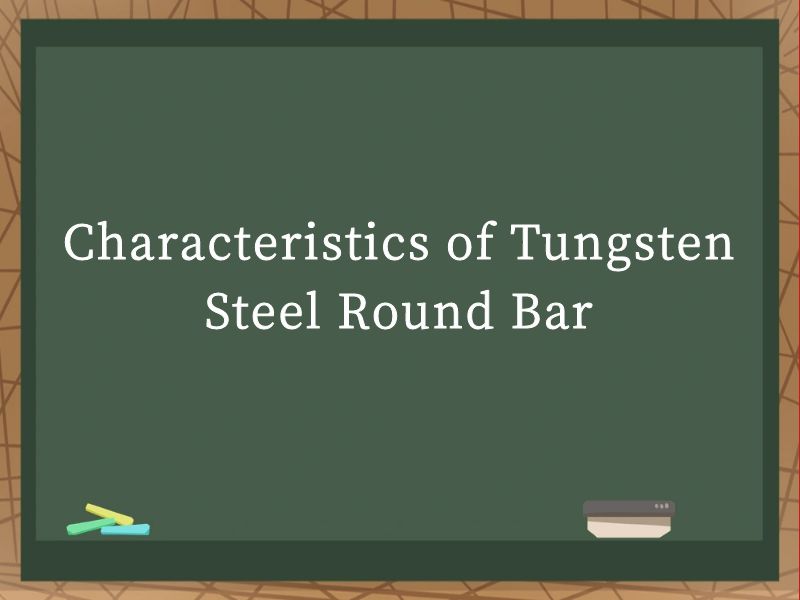JOURNALISM
- NEWS -
|
Characteristics of Tungsten Steel Round BarCharacteristics of Tungsten Steel Round Bar.Tungsten steel round bars, known for their exceptional properties, have gained prominence in various industrial applications. This article delves into the characteristics of tungsten steel round bars, exploring their unique attributes that make them indispensable in diverse fields. By understanding these characteristics, one can appreciate the versatility and performance capabilities of tungsten steel in round bar form.
Introduction to Tungsten Steel Tungsten steel, also referred to as high-speed steel (HSS), is an alloy that combines tungsten, carbon, chromium, vanadium, and other elements with iron. This composition results in a material with remarkable hardness, wear resistance, and red hardness—the ability to maintain hardness at elevated temperatures. Tungsten steel round bars are manufactured through processes such as hot rolling, forging, or annealing, which further enhance their physical and mechanical properties. 1. High Hardness One of the most突出 characteristics of tungsten steel round bars is their exceptional hardness. This hardness arises from the high carbon content and the presence of tungsten carbide (WC) particles within the microstructure. Tungsten carbide is one of the hardest materials known, contributing to the overall hardness of the alloy. The hardness of tungsten steel round bars enables them to withstand severe abrasive and impact loads, making them suitable for applications where wear resistance is crucial. The hardness of tungsten steel can be further increased through heat treatment processes, such as quenching and tempering. Quenching involves rapidly cooling the material from a high temperature to lock in its hardened state, while tempering relieves internal stresses and improves toughness without significantly compromising hardness. 2. Excellent Wear Resistance Wear resistance is another key characteristic of tungsten steel round bars. The hard, wear-resistant nature of tungsten carbide particles ensures that the material can withstand friction and abrasive wear over extended periods. This makes tungsten steel round bars ideal for components that are subject to sliding, rolling, or rubbing contacts, such as cutting tools, dies, and molds. The wear resistance of tungsten steel is particularly advantageous in environments where lubrication is minimal or non-existent. In such conditions, traditional materials may quickly degrade, leading to premature failure. Tungsten steel round bars, however, maintain their integrity and performance, reducing the need for frequent replacements and downtime. 3. High Red Hardness Red hardness refers to a material's ability to retain its hardness at high temperatures. Tungsten steel round bars exhibit exceptional red hardness, making them suitable for applications involving high-temperature operations. This characteristic is particularly important in cutting tools, where the material must maintain its cutting edge even at elevated temperatures generated by friction and heat generation. The high red hardness of tungsten steel is attributed to the stable carbide particles within its structure. These particles do not readily decompose or soften at high temperatures, ensuring that the material retains its hardness and cutting performance. This makes tungsten steel round bars ideal for high-speed machining operations, where the cutting tool must withstand both mechanical and thermal stresses. 4. Good Toughness and Strength Despite their hardness and wear resistance, tungsten steel round bars also possess good toughness and strength. Toughness refers to a material's ability to absorb energy and undergo plastic deformation before fracturing, while strength indicates its resistance to failure under tensile or compressive loads. The combination of hardness, toughness, and strength in tungsten steel round bars allows them to perform well in applications involving impact and shock loads. This makes them suitable for tools and components that must withstand both wear and fatigue, such as punches, drills, and reamers. The balance between hardness and toughness in tungsten steel is achieved through careful alloy composition and heat treatment. By adjusting the proportions of various alloying elements and optimizing the heat treatment process, manufacturers can tailor the mechanical properties of tungsten steel round bars to meet specific application requirements. 5. Thermal Stability Tungsten steel round bars exhibit excellent thermal stability, which refers to their ability to maintain their mechanical properties and dimensional stability over a wide range of temperatures. This characteristic is crucial in applications where temperature fluctuations can adversely affect material performance. The thermal stability of tungsten steel arises from its stable carbide particles and the careful selection of alloying elements. These elements form a stable microstructure that resists changes in properties due to temperature variations. As a result, tungsten steel round bars can be used in environments where traditional materials may experience dimensional changes, creep, or embrittlement. 6. Machinability Despite their hardness, tungsten steel round bars can be machined to precise dimensions using appropriate tooling and techniques. This machinability is essential for creating components with intricate shapes and tight tolerances. Machining tungsten steel round bars typically involves using carbide or ceramic cutting tools, which are harder and more wear-resistant than conventional tools. The cutting parameters, such as feed rate, spindle speed, and depth of cut, must be carefully selected to avoid excessive tool wear and heat generation. In addition to conventional machining methods, tungsten steel round bars can also be processed using advanced manufacturing techniques such as electrical discharge machining (EDM) and laser cutting. These techniques offer greater precision and flexibility in shaping complex geometries and thin-walled components. 7. Corrosion Resistance Tungsten steel round bars exhibit good corrosion resistance in many environments. The alloy composition and microstructure contribute to their ability to resist chemical attack from acids, bases, and other aggressive media. However, it is important to note that corrosion resistance can vary depending on the specific alloy composition and the environment in which the material is used. In highly corrosive environments, additional surface treatments or coatings may be required to protect the tungsten steel round bars from degradation. 8. Versatility in Applications The combination of hardness, wear resistance, red hardness, toughness, strength, thermal stability, machinability, and corrosion resistance makes tungsten steel round bars versatile in applications. They are widely used in the manufacturing industry for tools and components that require high performance and durability. For example, tungsten steel round bars are commonly used in the production of cutting tools such as drills, taps, reamers, and milling cutters. They are also used in dies and molds for forming and shaping metal parts. Additionally, tungsten steel round bars find applications in aerospace, automotive, and energy sectors, where components must withstand extreme conditions and perform reliably over extended periods. Conclusion Tungsten steel round bars are a highly versatile material with exceptional properties that make them suitable for a wide range of industrial applications. Their high hardness, wear resistance, red hardness, toughness, strength, thermal stability, machinability, and corrosion resistance contribute to their outstanding performance in demanding environments. By understanding the characteristics of tungsten steel round bars, engineers and manufacturers can select the most appropriate material for their specific applications. This ensures that tools and components made from tungsten steel round bars will perform reliably, reducing downtime, and maintenance costs while improving overall productivity and efficiency. As technology continues to advance, the demand for high-performance materials like tungsten steel round bars is likely to increase. Manufacturers must continue to innovate and improve their production processes to meet these demands, ensuring that tungsten steel round bars remain a vital component in the manufacturing industry. |


